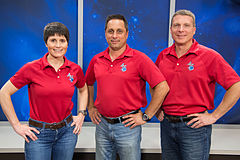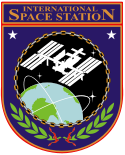Sojuz TMA-15M
| Dane misji | |
| Indeks COSPAR | 2014-074A |
|---|---|
| Zaangażowani | |
| Oznaczenie kodowe | Astriej (Astraeus) |
| Pojazd | |
| Statek kosmiczny | |
| Masa pojazdu | ok. 7200 kg |
| Rakieta nośna | |
| Załoga | |
 od lewej: S. Cristoforetti, A. Szkaplerow i T. Virts | |
| Dowódca | |
| Załoga | |
| Start | |
| Miejsce startu | |
| Początek misji | 23 listopada 2014, 21:01 UTC |
| Misja na Międzynarodową Stację Kosmiczną | |
| Lądowanie na ISS | 24 listopada 2014, 02:49 UTC |
| Pobyt na ISS | 199 dni, 7 godzin, 31 minut |
| Lądowanie | |
| Miejsce lądowania | |
| Lądowanie | 11 czerwca 2015, 13:44 UTC |
| Czas trwania misji | 199 dni, 16 godzin, 43 minuty |
| Liczba okrążeń Ziemi | 3107[1] |
| Program Sojuz | |
Sojuz TMA-15M – misja statku załogowego Sojuz do Międzynarodowej Stacji Kosmicznej, której celem było dostarczenie na orbitę i sprowadzenie na ziemię trojga kosmonautów. Był to 124. lot kapsuły Sojuz i jej 40. podróż na MSK.
Start odbył się z kosmodromu Bajkonur 23 listopada 2014 r. o 21:01 UTC przy pomocy rakiety nośnej Sojuz-FG[2], dla której był to 50. start w tej wersji (i 40. w konfiguracji bez członu Fregat[3]). Statek pozostał na MSK w charakterze kapsuły ewakuacyjnej i wylądował z tą samą załogą 11 czerwca 2015 r.[4]
Na początku misji lądowanie kapsuły TMA-15M planowane było na 16 maja[2]. Powrót został odłożony o prawie miesiąc z powodu nie dotarcia statku transportowego Progress M-27M w wyniku problemu z rakietą nośną Sojuz 2.1a w kwietniu tego roku. Opóźnienie zaowocowało m.in. pobiciem rekordu czasu pobytu na orbicie kosmonauty z Europy zachodniej oraz trwania lotu kobiety[4][5].
Ostatecznie statek odłączył się od MSK 11 czerwca o 10:20 UTC i wylądował w Kazachstanie już po trzech godzinach 24 minutach.
Załoga
Podstawowa
- Anton Szkaplerow (2) – dowódca (Rosja)
- Samantha Cristoforetti (1) – inżynier pokładowy (Włochy, ESA) – pierwsza Włoszka w przestrzeni kosmicznej, rekord długości kobiecego lotu.
- Terry Virts (2) – inżynier pokładowy (USA)
Rezerwowa
- Oleg Kononienko (3) – dowódca (Rosja)
- Kimiya Yui (1) – inżynier pokładowy (Japonia)
- Kjell Lindgren (1) – inżynier pokładowy (USA)
Galeria
Przypisy
- ↑ Soyuz TMA-15M (ang.). W: Spacefacts [on-line]. [dostęp 2017-06-19].
- ↑ a b Hubert Bartkowiak: Sojuz TMA-15M na ISS (pol.). Kosmonauta.net, 2014-11-24. [dostęp 2015-03-17].
- ↑ Soyuz-FG (11A511U-FG), Gunter's Space Page (space.skyrocket.de) [dostęp 2017-06-19] (ang.).
- ↑ a b dmi/ ro/: Statek Sojuz TMA-15M z kosmonautami pomyślnie wylądował w Kazachstanie (pol.). PAP, 2015-06-12. [dostęp 2015-06-15].
- ↑ Krzysztof Kanawka: Powrót Sojuza TMA-15M (11.06.2015) (pol.). Kosmonauta.net, 2015-06-11. [dostęp 2015-06-15].
Bibliografia
Media użyte na tej stronie
The Soyuz TMA-15M rocket launches from the Baikonur Cosmodrome in Kazakhstan on Monday, Nov. 24, 2014 as seen in this long exposure carrying Expedition 42 Soyuz Commander Anton Shkaplerov of the Russian Federal Space Agency (Roscosmos), Flight Engineer Terry Virts of NASA, and Flight Engineer Samantha Cristoforetti of the European Space Agency (ESA) into orbit to begin their five and a half month mission on the International Space Station.
The Soyuz TMA-15M spacecraft is rolled out to the launch pad by train on Friday, Nov. 21, 2014 at the Baikonur Cosmodrome in Kazakhstan. Launch of the Soyuz rocket is scheduled for Nov. 24 and will carry Expedition 42 Soyuz Commander Anton Shkaplerov of the Russian Federal Space Agency (Roscosmos), Flight Engineer Terry Virts of NASA , and Flight Engineer Samantha Cristoforetti of the European Space Agency into orbit to begin their five and a half month mission on the International Space Station.
NASA astronaut Terry Virts (right), Expedition 42 flight engineer and Expedition 43 commander; Russian cosmonaut Anton Shkaplerov and European Space Agency astronaut Samantha Cristoforetti, both Expedition 42/43 flight engineers, pose for a portrait following an Expedition 42/43 preflight press conference at NASA's Johnson Space Center.
Expedition 42 Flight Engineer Samantha Cristoforetti, of the European Space Agency (ESA), left, Soyuz Commander Anton Shkaplerov of the Russian Federal Space Agency (Roscosmos), center, and Flight Engineer Terry Virts of NASA, right, pose for a photo with senior officials of Roscosmos, NASA, and ESA prior to boarding the Soyuz TMA-15M spacecraft for launch, Monday, Nov. 24, 2014 at the Baikonur Cosmodrome in Kazakhstan. Cristoforetti, Virts, and Shkaplerov will spend the next five and a half months aboard the International Space Station.
At the Gagarin Cosmonaut Training Center in Star City, Russia, Expedition 42/43 crewmember Terry Virts of NASA signs a ceremonial book Nov. 6 as his crewmates, Anton Shkaplerov of the Russian Federal Space Agency (Roscosmos, front row center) and Samantha Cristoforetti of the European Space Agency (front row right) look on. In the back row are the backup crewmembers, Kjell Lindgren of NASA, Oleg Kononenko of Roscosmos and Kimiya Yui of the Japan Aerospace Exploration Agency. Virts, Cristoforetti and Shkaplerov will launch Nov. 24, Kazakh time from the Baikonur Cosmodrome in Kazakhstan on their Soyuz TMA-15M spacecraft for a 5 ½ month mission on the International Space Station.
Expedition 43 commander Terry Virts of NASA, left, cosmonaut Anton Shkaplerov of the Russian Federal Space Agency (Roscosmos), center, and Italian astronaut Samantha Cristoforetti from European Space Agency (ESA) sit in chairs outside the Soyuz TMA-15M spacecraft just minutes after they landed in a remote area near the town of Zhezkazgan, Kazakhstan on Thursday, June 11, 2015. Virts, Shkaplerov, and Cristoforetti are returning after more than six months onboard the International Space Station where they served as members of the Expedition 42 and 43 crews
NASA astronaut Terry Virts (foreground), Expedition 42 flight engineer and Expedition 43 commander; along with European Space Agency astronaut Samantha Cristoforetti and Russian cosmonaut Anton Shkaplerov, both Expedition 42/43 flight engineers, participate in a routine operations training session in an International Space Station mock-up/trainer in the Space Vehicle Mock-up Facility at NASA's Johnson Space Center.















